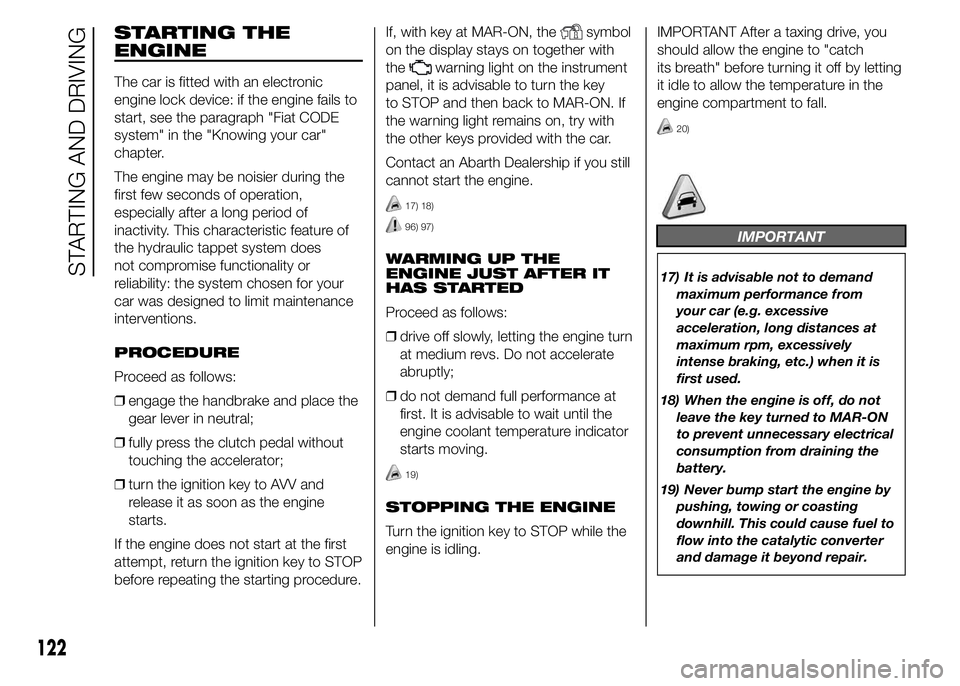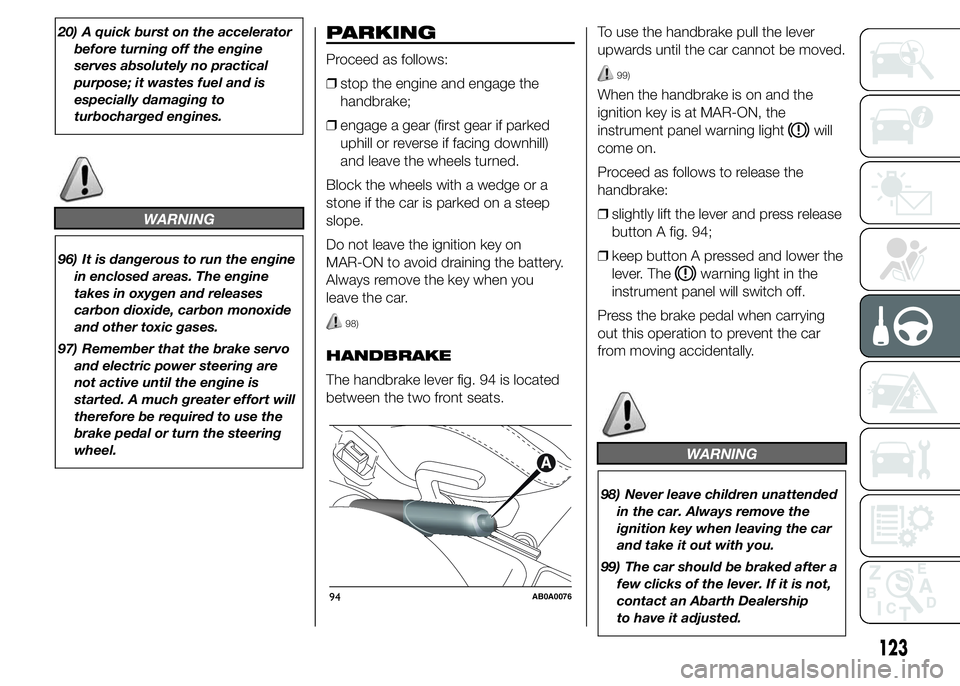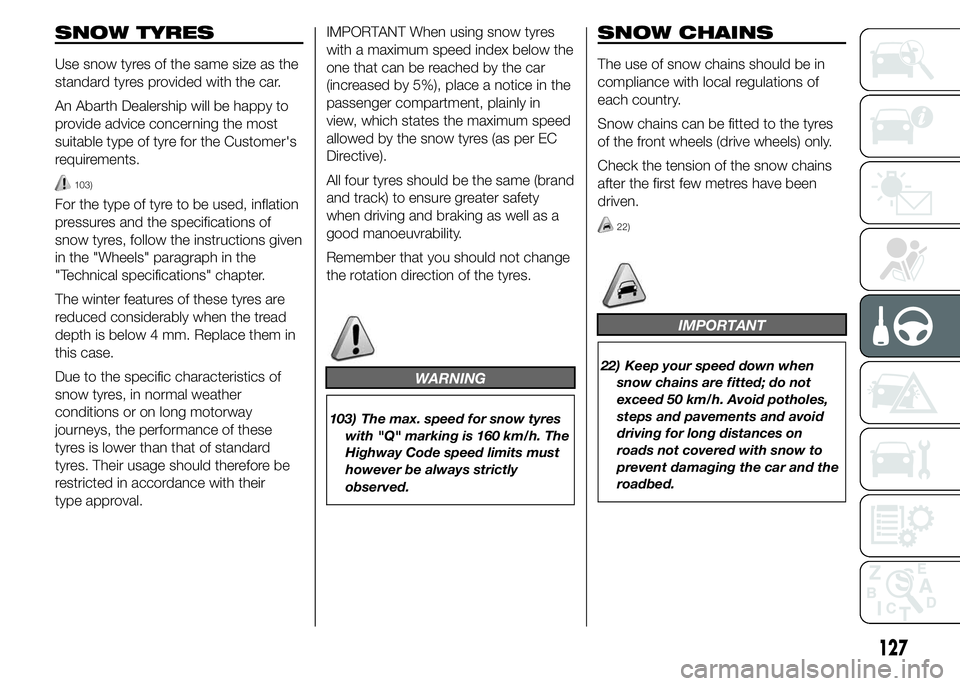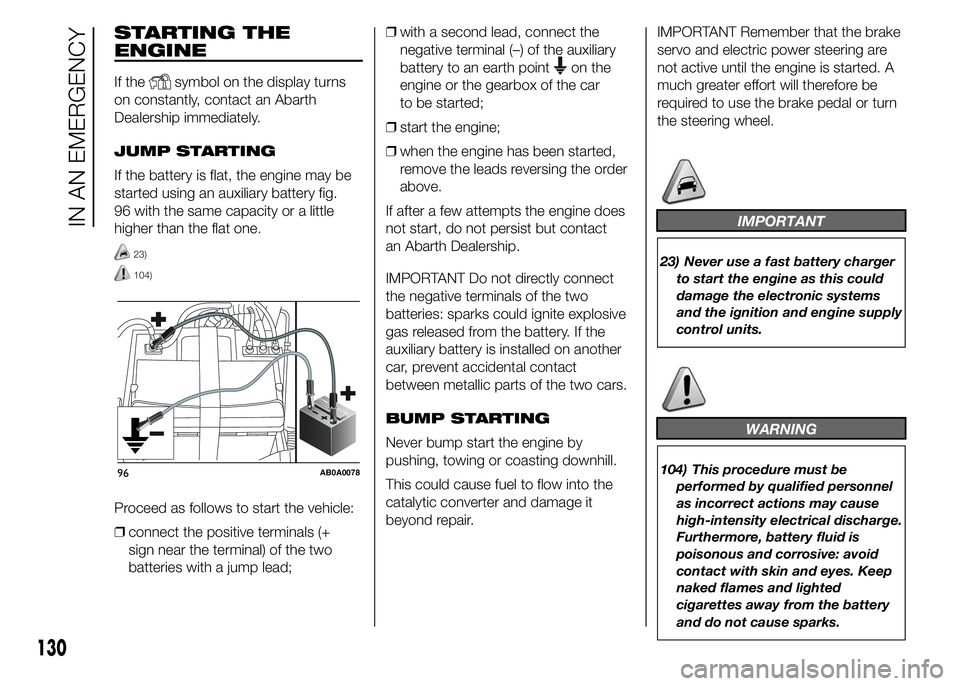warning Abarth 500 2016 Owner handbook (in English)
[x] Cancel search | Manufacturer: ABARTH, Model Year: 2016, Model line: 500, Model: Abarth 500 2016Pages: 215, PDF Size: 19.08 MB
Page 120 of 215

PASSENGER SIDE FRONT AIRBAG AND CHILD RESTRAINT SYSTEMS: WARNING
91AB0A0072
116
SAFETY
Page 121 of 215

WARNING
80) Do not apply stickers or other objects on the steering wheel, on the dashboard in the passenger side airbag area, on
the side cover on the roof and on the seats. Never put objects (e.g. mobile phones) on the passenger's side
dashboard since they could interfere with correct inflation of the airbag and also cause serious injury to the
passengers.
81) SEVERE DANGER: when an active passenger airbag is fitted, DO NOT install rear facing child restraint systems on
the front seat. Deployment of the airbag in an accident could cause fatal injuries to the child regardless of the
severity of the impact. Therefore, always deactivate the passenger side airbag when a rear facing child restraint
system is installed on the front passenger seat. The front passenger seat must also be positioned back as far
as possible in order to prevent the child restraint system from coming into contact with the dashboard. Immediately
reactivate the passenger airbag as soon as the child restraint system has been removed.
82) When an active passenger airbag is fitted, DO NOT install rear facing child restraint systems on the front seat.
Deployment of the airbag in an accident could cause fatal injuries to the child regardless of the severity of the
impact.
83) Warning light
indicates fault of warning light. This condition is indicated by intermittent blinking of warning
light
for longer than 4 seconds. In this case, thewarning light may not indicate a fault in the restraint systems.
Before driving off, contact an Abarth Dealership to have the system checked immediately.
117
Page 123 of 215

IMPORTANT The front airbags and/or
side bags may be deployed if the car is
subject to heavy knocks or accidents
involving the underbody area, such
as for example violent shocks against
steps, pavements or low obstacles, the
car falling in big holes or dips in the
road.
IMPORTANT A small amount of dust
will be released when the airbags
are deployed. The dust is not harmful
and does not indicate the beginning of
a fire. Furthermore, the surface of the
deployed bag and the interior of the car
may be covered by a dusty residue:
this may irritate skin and eyes. Wash
with mild soap and water in the event of
exposure.IMPORTANT Should an accident occur
in which any of the safety devices are
activated, take the vehicle to an Abarth
Dealership to have the activated
devices replaced and to have the whole
system checked.
Every control, repair and replacement
operation concerning the airbags must
only be carried out at an Abarth
Dealership. If the car is scrapped, have
the system deactivated at an Abarth
Dealership.
IMPORTANT Pretensioners, front
airbags and side bags are deployed
according to different logics on the
basis of the type of collision. Failure to
deploy of one of the devices does
not necessarily indicate a system
malfunction.
84) 85) 86) 87) 88) 89) 90) 91) 92) 93) 94) 95)
WARNING
84) Do not rest your head, arms or
elbows on the door, windows or
in the window bag area to prevent
injury during deployment.
85) Never lean your head, arms and
elbows out of the window.
86) If, when turning the key to
MAR-ON, the
warning light
does not turn on or if it stays on
when travelling, there could be
a fault in the restraint systems; in
this event airbags or
pretensioners may not be
deployed in the event of impact
or, in a lower number of cases,
they may deploy accidentally.
Before driving off, contact
an Abarth Dealership to have the
system checked immediately.
87) Do not cover the front seat
backrests with extra covers if they
are equipped with side bags.
119
Page 124 of 215

88) Always drive keeping your hands
on the steering wheel rim so that
the airbag can inflate freely if
necessary. Do not drive with your
body bent forward. Keep your
back straight against the
backrest.
89) If the car has been subject to
theft, attempted theft, vandalism,
or flooding, have the airbag
system inspected at an Abarth
Dealership.90) Airbags may be deployed if
another vehicle crashes into the
car, if the key is inserted and
at MAR-ON even if the engine is
not running and the car is
stationary. Therefore, even if the
car is stationary, when an active
front passenger airbag is fitted,
DO NOT install rear facing child
restraint systems on the front
passenger seat. Deployment of
the airbag following an impact
could cause fatal injuries to the
child. Therefore, always
deactivate the passenger airbag
when a rear facing child restraint
system is installed on the front
passenger seat. The front
passenger seat must also be
positioned back as far as possible
in order to prevent the child
restraint system from coming into
contact with the dashboard.
Immediately reactivate the
passenger airbag as soon as the
child restraint system has been
removed. Also remember that,
if the key is turned to STOP, none
of the safety devices (airbags or
pretensioners) will be deployed in
the event of collision. Non-
deployment in such cases does
not indicate a system malfunction.91) When the ignition key is turned
to MAR-ON, the
warning light
turns on and flashes for a few
seconds to remind you that the
passenger's airbag will be
deployed in a crash, after which it
should switch off.
92) Do not wash the seats with
water or pressurised steam (wash
by hand or at automatic car seat
washing stations).
93) The front airbag deployment
threshold is higher than that of
the pretensioners. For collisions in
the range between the two
thresholds, it is normal for only
the pretensioners to be activated.
94) Do not affix rigid objects to the
coat hooks or support handles.
95) The airbag does not replace seat
belts but increases their
effectiveness. Furthermore, since
front airbags are not deployed
in low-speed frontal impacts, side
impacts, rear shunts or roll-overs,
the passengers are protected
only by the seat belts which must
therefore be fastened at all times.
120
SAFETY
Page 126 of 215

STARTING THE
ENGINE
The car is fitted with an electronic
engine lock device: if the engine fails to
start, see the paragraph "Fiat CODE
system" in the "Knowing your car"
chapter.
The engine may be noisier during the
first few seconds of operation,
especially after a long period of
inactivity. This characteristic feature of
the hydraulic tappet system does
not compromise functionality or
reliability: the system chosen for your
car was designed to limit maintenance
interventions.
PROCEDURE
Proceed as follows:
❒engage the handbrake and place the
gear lever in neutral;
❒fully press the clutch pedal without
touching the accelerator;
❒turn the ignition key to AVV and
release it as soon as the engine
starts.
If the engine does not start at the first
attempt, return the ignition key to STOP
before repeating the starting procedure.If, with key at MAR-ON, the
symbol
on the display stays on together with
the
warning light on the instrument
panel, it is advisable to turn the key
to STOP and then back to MAR-ON. If
the warning light remains on, try with
the other keys provided with the car.
Contact an Abarth Dealership if you still
cannot start the engine.
17) 18)
96) 97)
WARMING UP THE
ENGINE JUST AFTER IT
HAS STARTED
Proceed as follows:
❒drive off slowly, letting the engine turn
at medium revs. Do not accelerate
abruptly;
❒do not demand full performance at
first. It is advisable to wait until the
engine coolant temperature indicator
starts moving.
19)
STOPPING THE ENGINE
Turn the ignition key to STOP while the
engine is idling.IMPORTANT After a taxing drive, you
should allow the engine to "catch
its breath" before turning it off by letting
it idle to allow the temperature in the
engine compartment to fall.
20)
IMPORTANT
17) It is advisable not to demand
maximum performance from
your car (e.g. excessive
acceleration, long distances at
maximum rpm, excessively
intense braking, etc.) when it is
first used.
18) When the engine is off, do not
leave the key turned to MAR-ON
to prevent unnecessary electrical
consumption from draining the
battery.
19) Never bump start the engine by
pushing, towing or coasting
downhill. This could cause fuel to
flow into the catalytic converter
and damage it beyond repair.
122
STARTING AND DRIVING
Page 127 of 215

20) A quick burst on the accelerator
before turning off the engine
serves absolutely no practical
purpose; it wastes fuel and is
especially damaging to
turbocharged engines.
WARNING
96) It is dangerous to run the engine
in enclosed areas. The engine
takes in oxygen and releases
carbon dioxide, carbon monoxide
and other toxic gases.
97) Remember that the brake servo
and electric power steering are
not active until the engine is
started. A much greater effort will
therefore be required to use the
brake pedal or turn the steering
wheel.
PARKING
Proceed as follows:
❒stop the engine and engage the
handbrake;
❒engage a gear (first gear if parked
uphill or reverse if facing downhill)
and leave the wheels turned.
Block the wheels with a wedge or a
stone if the car is parked on a steep
slope.
Do not leave the ignition key on
MAR-ON to avoid draining the battery.
Always remove the key when you
leave the car.
98)
HANDBRAKE
The handbrake lever fig. 94 is located
between the two front seats.To use the handbrake pull the lever
upwards until the car cannot be moved.
99)
When the handbrake is on and the
ignition key is at MAR-ON, the
instrument panel warning light
will
come on.
Proceed as follows to release the
handbrake:
❒slightly lift the lever and press release
button A fig. 94;
❒keep button A pressed and lower the
lever. The
warning light in the
instrument panel will switch off.
Press the brake pedal when carrying
out this operation to prevent the car
from moving accidentally.
WARNING
98) Never leave children unattended
in the car. Always remove the
ignition key when leaving the car
and take it out with you.
99) The car should be braked after a
few clicks of the lever. If it is not,
contact an Abarth Dealership
to have it adjusted.
94AB0A0076
123
Page 128 of 215

USING THE
GEARBOX
To engage the gears, press the clutch
pedal fully and put the gear lever into
the required position (the diagram
for gear engagement is shown on the
knob) fig. 95.
100)
21)
To engage reverse R from neutral,
move the lever to the right and then
backwards.
To assist the transmission of torque, a
limit on the engine revs when setting off
at 2,700 rpm can be noticed. When
the clutch pedal is released and the
vehicle is being driven, the engine revs
restriction is disabled.IMPORTANT Reverse can only be
engaged when the car is completely
stationary. With the engine running, wait
for at least 2 seconds with the clutch
pedal fully pressed before engaging
reverse to prevent damage to the gears
and grating.
IMPORTANT The clutch pedal should
be used only for gear changes. Do
not drive with your foot resting on the
clutch pedal, however lightly. For
versions/markets where provided, the
electronic clutch control could cut
in, interpreting the incorrect driving style
as a fault.
WARNING
100) Depress the clutch pedal fully
to change gear correctly.
Therefore, the floor area
underneath the pedal unit must
not be obstructed in any way.
Ensure that the floor mat is
always laid flat and does not
interfere with use of the pedals.
IMPORTANT
21) Do not drive with your hand
resting on the gear lever as the
force exerted, even if slight, could
lead over time to premature wear
of the internal gearbox
components.
24R351
95AB0A0077
124
STARTING AND DRIVING
Page 130 of 215

CONDITIONS OF USE
Cold starting
Short journeys and frequent cold starts
do not allow the engine to reach
optimum operating temperature. This
results in a significant increase in
consumption levels (from +15 to +30%
on the urban cycle) and emissions.
Traffic and road
conditions
High fuel consumption is caused by
heavy traffic, for instance when
travelling in a queue with frequent use
of low gears or in cities with many traffic
lights. Winding mountain roads and
rough road surfaces also adversely
affect consumption.
Stops in traffic
During prolonged hold-ups (e.g. level
crossings) switch off the engine.TOWING TRAILERS
IMPORTANT
INFORMATION
For towing caravans or trailers the car
must be fitted with a certified tow hook
and an adequate electrical system.
Installation should be carried out by
specialised personnel who will issue the
required papers for travelling on roads.
Install any specific and/or additional
door mirrors as specified by the
Highway Code.
Remember that when towing a trailer,
steep hills are harder to climb, braking
distances increase and overtaking
takes longer depending on the overall
weight of the trailer.
Engage a low gear when driving
downhill, rather than constantly using
the brake.
The weight the trailer exerts on the car
tow hook reduces the car's loading
capacity by the same amount. To make
sure that the maximum towable weight
is not exceeded (given in the car
registration document) account should
be taken of the fully laden trailer,
including accessories and luggage.Respect the speed limits specific to
each country for vehicles towing
trailers.
In any case, the top speed must not
exceed 100 km/h.
101) 102)
WARNING
101) The ABS with which the car is
equipped will not control the
braking system of the trailer.
Particular caution is therefore
required on slippery surfaces.
102) Never modify the braking
system of the car to control the
trailer brake. The trailer braking
system must be fully independent
of the car’s hydraulic system.
126
STARTING AND DRIVING
Page 131 of 215

SNOW TYRES
Use snow tyres of the same size as the
standard tyres provided with the car.
An Abarth Dealership will be happy to
provide advice concerning the most
suitable type of tyre for the Customer's
requirements.
103)
For the type of tyre to be used, inflation
pressures and the specifications of
snow tyres, follow the instructions given
in the "Wheels" paragraph in the
"Technical specifications" chapter.
The winter features of these tyres are
reduced considerably when the tread
depth is below 4 mm. Replace them in
this case.
Due to the specific characteristics of
snow tyres, in normal weather
conditions or on long motorway
journeys, the performance of these
tyres is lower than that of standard
tyres. Their usage should therefore be
restricted in accordance with their
type approval.IMPORTANT When using snow tyres
with a maximum speed index below the
one that can be reached by the car
(increased by 5%), place a notice in the
passenger compartment, plainly in
view, which states the maximum speed
allowed by the snow tyres (as per EC
Directive).
All four tyres should be the same (brand
and track) to ensure greater safety
when driving and braking as well as a
good manoeuvrability.
Remember that you should not change
the rotation direction of the tyres.
WARNING
103) The max. speed for snow tyres
with "Q" marking is 160 km/h. The
Highway Code speed limits must
however be always strictly
observed.
SNOW CHAINS
The use of snow chains should be in
compliance with local regulations of
each country.
Snow chains can be fitted to the tyres
of the front wheels (drive wheels) only.
Check the tension of the snow chains
after the first few metres have been
driven.
22)
IMPORTANT
22) Keep your speed down when
snow chains are fitted; do not
exceed 50 km/h. Avoid potholes,
steps and pavements and avoid
driving for long distances on
roads not covered with snow to
prevent damaging the car and the
roadbed.
127
Page 134 of 215

STARTING THE
ENGINE
If thesymbol on the display turns
on constantly, contact an Abarth
Dealership immediately.
JUMP STARTING
If the battery is flat, the engine may be
started using an auxiliary battery fig.
96 with the same capacity or a little
higher than the flat one.
23)
104)
Proceed as follows to start the vehicle:
❒connect the positive terminals (+
sign near the terminal) of the two
batteries with a jump lead;❒with a second lead, connect the
negative terminal (–) of the auxiliary
battery to an earth point
on the
engine or the gearbox of the car
to be started;
❒start the engine;
❒when the engine has been started,
remove the leads reversing the order
above.
If after a few attempts the engine does
not start, do not persist but contact
an Abarth Dealership.
IMPORTANT Do not directly connect
the negative terminals of the two
batteries: sparks could ignite explosive
gas released from the battery. If the
auxiliary battery is installed on another
car, prevent accidental contact
between metallic parts of the two cars.
BUMP STARTING
Never bump start the engine by
pushing, towing or coasting downhill.
This could cause fuel to flow into the
catalytic converter and damage it
beyond repair.IMPORTANT Remember that the brake
servo and electric power steering are
not active until the engine is started. A
much greater effort will therefore be
required to use the brake pedal or turn
the steering wheel.
IMPORTANT
23) Never use a fast battery charger
to start the engine as this could
damage the electronic systems
and the ignition and engine supply
control units.
WARNING
104) This procedure must be
performed by qualified personnel
as incorrect actions may cause
high-intensity electrical discharge.
Furthermore, battery fluid is
poisonous and corrosive: avoid
contact with skin and eyes. Keep
naked flames and lighted
cigarettes away from the battery
and do not cause sparks.96AB0A0078
130
IN AN EMERGENCY